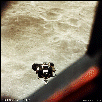|
| |

Apollo 10
 |
(C)
Thomas P. Stafford |
Commander |
| (R) John W. Young |
Command Module Pilot |
| (L) Eugene A. Cernan |
Lunar Module Pilot |
Crew Spaceflight Histories
| Thomas P. Stafford* |
| |
Mission |
Dates |
Role |
Notes |
|
Gemini VI-A |
December 15-17, 1965 |
Pilot |
first space rendezvous w/
Gemini VII |
|
Gemini IX-A |
July 18-21, 1966 |
Commander |
|
| |
Apollo
10 |
May 18-26, 1969 |
Commander |
lunar orbit, closest
approach |
| |
ASTP |
July 15-24, 1975 |
Commander |
|
| |
| John W. Young |
| |
Mission |
Dates |
Role |
Notes |
| |
Gemini 3 |
March 23, 1965 |
Pilot |
first to use computer on
manned space flight. |
| |
Gemini X |
July 18-21, 1966 |
Commander |
|
| |
Apollo
10 |
May 18-26, 1969 |
Command Module Pilot |
lunar orbit, closest
approach |
|
Apollo
16 |
April 16-27, 1972 |
Commander |
lunar landing |
|
STS-1 |
April 12-14, 1981 |
Commander |
maiden flight of
Space Shuttle "Columbia" |
|
STS-9 |
Nov 28 - Dec 8, 1983 |
Commander |
first flight of Spacelab |
| |
| Eugene Cernan |
| |
Mission |
Dates |
Role |
Notes |
|
Gemini IX-A |
July 18-21, 1966 |
Pilot |
|
| |
Apollo
10 |
May 18-26, 1969 |
Lunar Module Pilot |
lunar orbit, closest
approach |
| |
Apollo
17 |
December 7-19,
1972 |
Commander |
Last man to
walk on the Moon. |
Apollo 10 Backup Crew:
The
Apollo 10 spacecraft was launched from Cape Kennedy at 12:49 p.m., EDT, on May
18, 1969. This liftoff marked the fourth manned Apollo launch in the short space
of seven months. After the spacecraft completed one and a half revolutions of
the Earth, the S-IVB
booster stage was reignited to increase the speed of the spacecraft to the
velocity required to escape the gravitational attraction of the Earth. Three
days later, the spacecraft was placed in a 60-
by 170-nautical miles orbit around the Moon. After the spacecraft completed
two revolutions of the Moon, orbit was circularized to 60 nautical miles by a
second burn of the service propulsion system.
- Nineteen color television
transmissions (totaling 5 hours 52 minutes) of remarkable quality provided
the world audience the best exposure yet to spacecraft activities and
spectacular views of the earth and the moon.
 On
the fifth day of the mission, Astronauts Thomas P. Stafford and Eugene A. Cernan
descended in the lunar module to an altitude of less than 47,000 feet (14,326
meters) above the Moon. At this altitude, two passes were made over the future Apollo
11 landing site. The LM then completed a successful rendezvous with
Astronaut John W. Young in the command module. On
the fifth day of the mission, Astronauts Thomas P. Stafford and Eugene A. Cernan
descended in the lunar module to an altitude of less than 47,000 feet (14,326
meters) above the Moon. At this altitude, two passes were made over the future Apollo
11 landing site. The LM then completed a successful rendezvous with
Astronaut John W. Young in the command module.
During the mission, the
astronauts obtained hundreds of still
photographs and exposed many reels of motion-picture film.
On May 24, the service propulsion
system was reignited, and the astronauts began the return journey to Earth.
Splashdown occurred at 12:52 p.m. on May 26, 1969, less than 4 miles (6.4 km)
from the target point and the recovery ship.
| Launch: |
May 18, 1969
16:49:00 UT (12:49:00 p.m. EDT)
Kennedy Space Center Launch Complex 39B |
| Lunar Orbit: |
May 21, 1969 |
| Returned to Earth: |
May 26., 1969
splashdown 16:52:23 UT (12:52:23 p.m. EDT) |
| Mission Duration: |
192 hours 3 minutes
23 seconds |
| Retrieval site: |
Pacific Ocean 15°
2' S, 164° 39' W |
| Retrieval ship: |
U.S.S. Princeton |
- Demonstration of color TV camera.
- Second Apollo mission to orbit the Moon.
- First time the complete Apollo spacecraft had
operated around the Moon and the second manned flight for the lunar
module.
- Two Apollo 10 astronauts descended to within eight
nautical miles (14 kilometers) of the Moon's surface, the closest approach
ever to another celestial body.
- All aspects of Apollo 10 duplicated conditions of
the lunar landing mission as closely as possible--Sun angles at Apollo
Site 2, the out-and-back flight path to the Moon, and the time line of
mission events. Apollo 10 differed from Apollo
11 in that no landing was made on the Moon's surface.
- Apollo 10 was the only Apollo mission to launch
from Launch Complex 39B.
- Maximum separation between the LM and the CSM
during the rendezvous sequence was about 350 miles (563 km) and provided
an extensive checkout of the LM rendezvous radar as well as the backup VHS
ranging device aboard the CSM, flown for the first time on Apollo 10.
|
